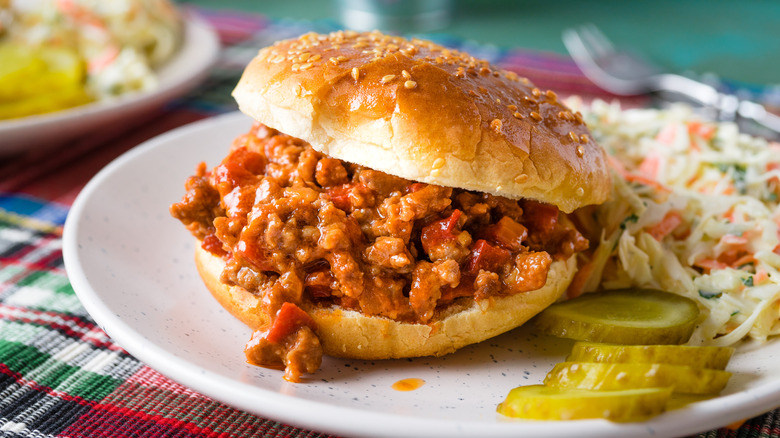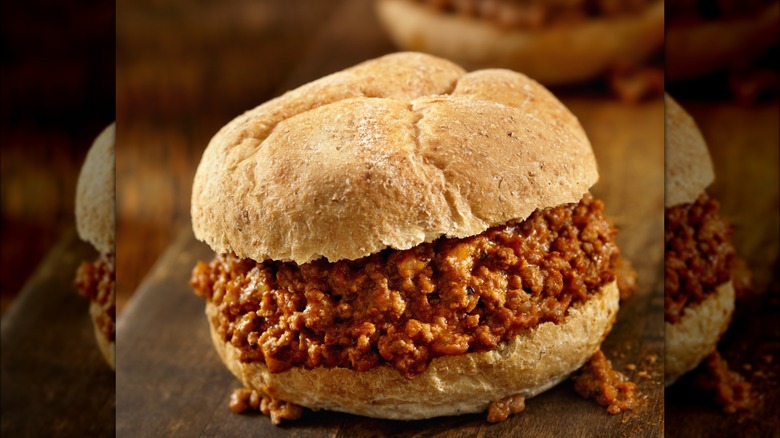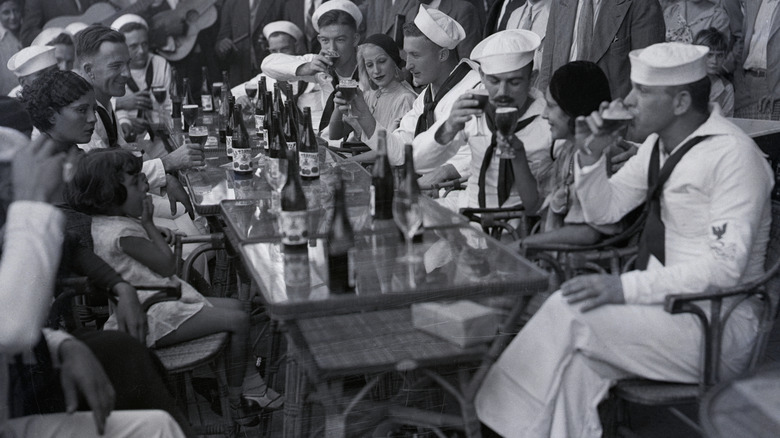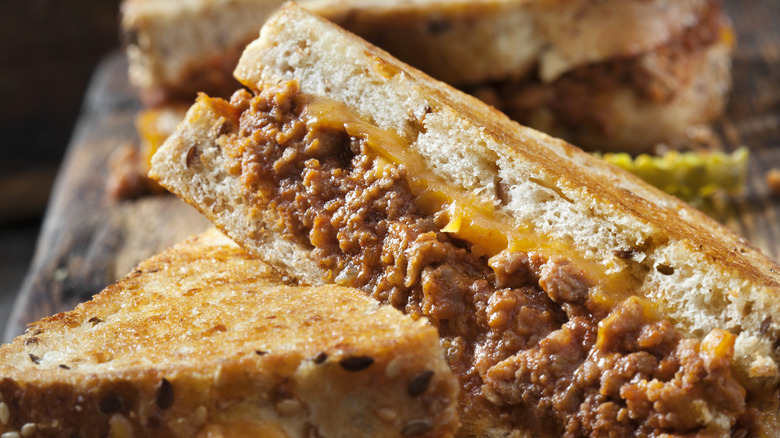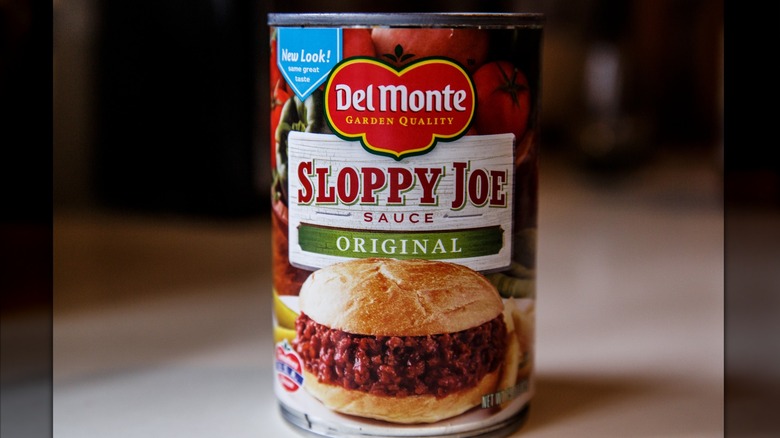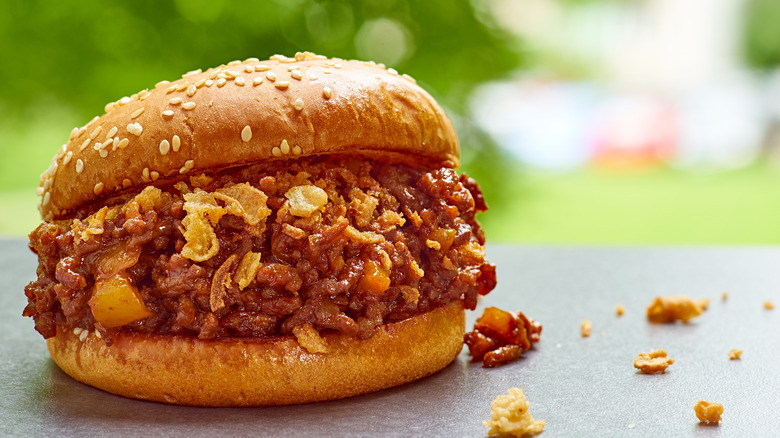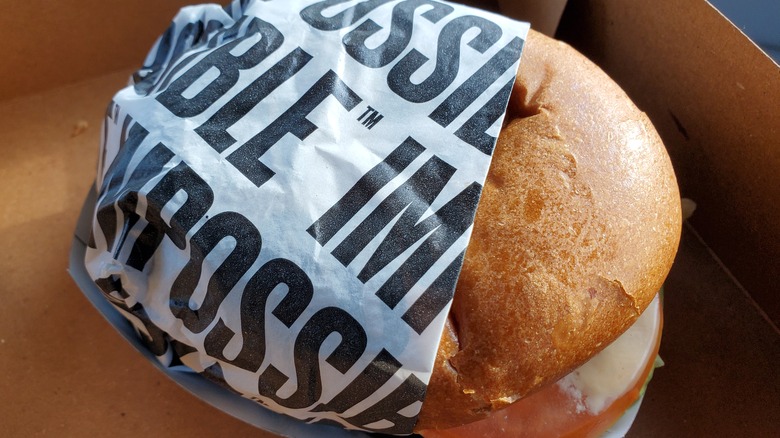The Mysterious History Of Sloppy Joes
Sloppy joes are way more than just a sandwich. They are a school cafeteria legend, an after-work indulgence, and an overall homemade classic. You can easily buy the ground beef and tomato filling in a can at the grocery store and add it to some bread for a 5-minute dinner, or you can whip up a quick and easy sloppy joe right on your own burners. Just throw a pound or so of meat into a pan along with peppers, onions, tomato sauce, and the one ingredient that real sloppy joe purists will never exclude: Ketchup. Slide the mixture into a soft hamburger bun and take a huge bite. The flavor of tomato-infused beef is truly timeless.
However, as classic as the taste of a sloppy joe truly is, nobody seems to agree on where the sandwich comes from. Some sources allege that the original "Joe" was a master cook from Iowa, who guarded the recipe of his best dish until he was on his deathbed. Others yet claim that "Joe" wasn't a cook but rather the name of a restaurant — and that the first "Sloppy Joe" was really a casual eatery in Florida's Key West. Yet more people believe that the sloppy joe is not even from the United States at all. While it's hard to pinpoint who exactly made the first sloppy joe, the sandwich's contradictory origin stories tell us that its invention is something of a modern mystery.
An Iowan restaurant has laid claim to the chopped meat sandwich
Although several restaurants call themselves the original home of the sloppy joe, few have as legitimate a claim to fame as Ye Olde Tavern. Located in Sioux Falls, Iowa, this establishment was a Midwestern classic that remained open for almost exactly 100 years. According to the local radio station, KKRC, Ye Olde Tavern was opened in 1920 by its original proprietor, Dave Heglin. The story goes that one of Heglin's top cooks was a man named Joe who developed a top-secret recipe for a chopped meat sub called the "Tavern Sandwitch" [sic]. Apparently, this early version of the sloppy joe took off and, even after the restaurant changed ownership, Ye Olde Tavern continued to serve the original sandwich recipe. At the time, customers could reportedly get them wrapped in wax paper, and they sold for just ten cents a pop.
Regardless of whether or not this was truly the first sloppy joe ever made, one thing is clear: The sandwich made at this Iowa tavern boasted extraordinarily high quality. Former restaurant owner Bertha Kaled told Sioux City Public Library that the secret to the eatery's famous tavern sandwich was that it relied on high-quality ingredients. As the retired restauranteur put it, she would only buy buns from the best local bakeries "because we used nothing but the finest meat."
The real sloppy joe might have come from Cuba
While Ye Olde Tavern has laid a strong claim on the sloppy joe, there is another restaurant that might have an even more convincing history with the sandwich. As explained by Food & Wine, the original Joe might not have been named Joe at all — but rather José.
In 1918, Spanish-born bartender José Abeal y Otero opened a bar in Havana, Cuba. A world traveler with experience working in Miami and New Orleans, Abeal y Otero had plenty of American buddies, who apparently nicknamed him "Joe." As revealed by the bar's 1932 cocktail menu, when the Spaniard invited his American friends to check out his new business, they told him that the place was a mess. Soon, everyone was calling the joint "Sloppy Joe's," and it had become a Havana favorite.
While Sloppy Joe's bar was especially famous for its cocktails — it was, after all, a popular tourist destination in the days of the American Prohibition era — many people believe that it also became known for its food. One of the location's most popular eats was said to be traditional, Cuban ropa vieja served on bread. This "Sloppy Joe sandwich" would have been filled with shredded beef stewed in tomatoes and spiced with a dash of cumin. Because of the similarities between this ropa vieja sandwich and the original sloppy joe, it would make a whole lot of sense for the dish to have originated in Cuba.
Key West could also be the home of the sloppy joe
Just ninety miles from where José Abeal y Otero was running Sloppy Joe's in Havana, there were two Key West establishments that were apparently serving similar sandwiches. Captain Tony's has long claimed to be the birthplace of the sloppy joe sandwich. Meanwhile, another bar — also named Sloppy Joe's — says that they invented the sandwich. Both establishments have been so confident about the matter that they have actually gone to court over who can make this claim.
While it does seem that Captain Tony's and the Floridian Sloppy Joe's bar have both served a chopped meat sub for decades, rumor has it that they adopted the dish based on its success in Havana. What's more, according to a report by The Takeout, the sandwich might have even traveled across the Florida Strait thanks to the intervention of famous writer Ernest Hemingway. Apparently, Hemingway loved to drink at Sloppy Joe's bar in Havana — and was a serious fan of the sandwich. Because of this, when his buddy, Joe Russell, began running his own bar in Key West, the writer encouraged the business owner to begin serving sloppy joe sandwiches as well. Ultimately, this menu addition was a massive success, leading Russell to go so far as to change the name of his bar from Silver Slipper to Sloppy Joe's. To this day, you can still enjoy a sloppy joe at this Florida establishment.
Sloppy joes are probably somewhat related to the hamburger
Regardless of who actually invented the sloppy joe, the truth is that the sandwich probably evolved out of some other dish. According to the History Channel, the end of the 19th century saw chopped and ground meats growing in popularity throughout the United States. The reason for this was a combination of contemporary health regulations and the improvement of meat grinding technologies. Notably, during the 1860s, the famous physician, Dr. James H. Salisbury, began encouraging people to treat digestive issues by consuming beef patties, and soon "Salisbury steaks" became popular in American homes. Around this same time, meat grinding tools also improved, giving a cheap way to make the preparation of ground beef way easier for local butchers. For the first time ever, these professionals were able to grind down less expensive parts of the animal, like fat and gristle, and sell it to the working class at a much more reasonable price. Ground beef took off.
Soon, ground meat dishes, including hamburgers and breakfast sausages, were a household staple. By the time the 1920s and '30s were rolling in, loose meat sandwiches were one of the most common ways to feed one's family. As explained by KDHL Radio, in general, these recipes were a great way to fill bellies on the cheap. While there were many sandwich varieties available at the time, the concept of loosely packed ground beef subs was quite reminiscent of the modern sloppy joe.
Canned sloppy joes brought the dish into noteriety
Because Americans were so used to eating different kinds of ground meat, it did not take long for the sloppy joe sandwich to catch on — so, when a canned version of this filling was introduced in the 1960s, the treat became ever more popular. As revealed in a 1965 Life Magazine advertisement published in Quaint Cooking, Libby's was selling canned BBQ sauce and beef "Sloppy Joes" as early on as the mid-'60s. What's more, per The Takeout, Manwich's 1969 sloppy joe in a can also made the sandwich extraordinarily simple to prepare. All you had to do was pop open a can, heat up the filling, and spread it on a piece of bread. The result was an easy-to-make dinner that was available at a very low price. Unsurprisingly, Americans loved it.
Interestingly though, Manwich, in particular, added an unusual twist to the way that sloppy joes were perceived in society. Through its advertising campaign, the company proposed a link between its canned sandwich filling and gender, stating, "A sandwich is a sandwich, but a Manwich is a meal." The assumption, at the time, was that the sloppy joe was a true "man's" meal. Although this advertising tactic would probably not be so effective in today's market, it was successful at the time. Manwich effectively made the ground meat sandwich a popular dinner item in households across the country.
They might have inspired a fashion movement
As sloppy joes became more and more integral to American culture, their unusual name began to appear outside culinary contexts. At one point, there was even a fashion movement that shared the sandwich's name. Indeed, advertisements from the 1940s show that girls used to wear "sloppy joe" sweaters. These cardigans were loose-fitting, hanging over one's shoulders to give a more casual vibe. Girls would pair them with skirts and penny loafers for a fun yet messy look.
The sloppy joe style was a popular one, sticking around for decades. According to the book, "Dress Casual: How College Students Redefined American Style" by Deidre Clemente, students loved their oversized sloppy joe sweaters through the 1950s and '60s. While past generations reportedly reeled at this "messy" look, embracing this look was very much the cool thing to do. As Clemente's work revealed, the Radcliffe student newspaper exalted the rebellious style as "sloppy, unrestrained, but always in good taste." In some ways, this fashion movement mirrored the way that sloppy joe sandwiches became known as the fun and messy lunch of the American youth.
Sloppy joes became known as a cool, young people's lunch
Much in the same way that sloppy joe fashion became synonymous with America's "modern" youth in the 1950s and '60s, sloppy joe sandwiches became the symbolic meal of young people of the same era. As Mary Moore explained in a 1969 article for The Windsor Star (via Quaint Cooking), teenagers were wild about this messy yet inexpensive meal. Compellingly, she was far from being the only author who thought so. Over a decade earlier, in 1952, a piece in the Spokesman Review reportedly declared, "When the teenage gang descends on your home for eats let it be 'Sloppy Joes' and plenty of them."
With time, companies began marketing the sloppy joe directly to teenagers. One issue of Life Magazine from 1965 featured an advertisement that read, "Sloppy Joes are neat!" with a photo showing four casually dressed teenagers grinning as they held the sandwiches in their hands. In the spirit of adolescent rebellion, there were no plates or forks in sight. This sort of advertising helped spread the idea that sloppy joes were the kind of informal, rule-breaking food that young people longed to consume.
The sandwich became a cafeteria staple
Perhaps due to the sloppy joe's reputation as a popular food for teens, school cafeterias across the U.S. began to serve these sandwiches for lunch. Fascinatingly, this item has seemed to stick to lunch menus for decades. American public schools have continued to serve this staple for many reasons. For one thing, it's filling and a good source of nutrition. For another, it is easy to make on a budget.
Rob Jaber, who directs the Office of Food and Nutrition Services for the District of Columbia, has explained that sloppy joes are oftentimes the key to serving students a well-rounded lunch. Per Weird Food History, the food expert explained, "The sloppy Joe — if served properly — can be the perfect combination of economics, nutrition, heartiness, and student acceptance." In his opinion, this dish ticks off enough boxes that it is "the perfect fit for a school menu."
They appeared in mass media
In the end, school lunches transformed sloppy joe sandwiches from a typical dinner to a typical piece of American culture. Before long, the lunch item was not just appearing on plates or in fashion magazines — it was also showing up in mass media.
One of the best examples of this occurred in 1994 when comedian Adam Sandler made a guest appearance on "Saturday Night Live." In one skit, Sandler played the guitar and narrated a story about cafeteria food rising up against a lunch lady. Naturally, the sloppy joe was one of the most important parts of the show. This dish (which was really actor and comedian Kevin Nealon in a costume) ended the conflict by sweeping the lunch lady off her feet, slow dancing with her and, eventually, getting married. While totally quirky, this skit does show what an integral part of American lunch culture the sloppy joe truly was.
Just one year later, the dish made another major media appearance — this time in the hit Mary-Kate and Ashley Olsen movie "It Takes Two." In this film, one of the girls goes to a school cafeteria where she notices dozens of other kids devouring their sloppy joe lunches. She tries hers and likes it so much that she proceeds to smash her face into the burger, smearing sauce all over her cheeks. Olsen then declares it a "big, gooey, messy burger."
Fast food restaurants have served the sandwich
Of course, school cafeterias are far from being the only place you can go to enjoy a good quality sloppy joe. Over the years, fast food chains have been known to serve this popular lunchtime sandwich. While McDonald's has largely kept this dish off of its menu, other brands have not been so hesitant. White Castle, in particular, has responded to the uptick in demand for sloppy joes, offering multiple limited-time-only menu items over the years.
In December 2022, the fast-food restaurant introduced the Sloppy Joe Slider. This was essentially a classic sloppy sandwich made with tomatoes, bell peppers, and onions and served on a smaller bun. Meanwhile, the company's Smoky Joe Slider offered a new twist on the traditional dish. Topped with "smoky cheese" and "crispy onions," this menu item tried to add a toasted flavor to the old-fashioned joe. Interestingly, the brand also gave patrons the chance to add a bit of heat to their sandwiches, giving them the chance to opt for jalapeño cheese, as well.
White Castle's corporate office has said that sloppy joes remain one of their cold-weather favorites. As the company's vice president, Jamie Richardson, told PR Newswire, "Sloppy joe remains a favorite for many people because it is a hearty meal needed during the cold winter months." He went on to say that the dish could really "provide comfort."
Sloppy joes keep on evolving
As time goes on, new versions of the old-fashioned sloppy joe continue to emerge. Cheese fans love adding a gooey topping to this delicious meal, while folks on the hunt for some crunch have been known to sprinkle chopped pickles on top. The canned version remains popular, but that has not prevented new homemade iterations of the dish from popping up. If you are cooking for a crew, for example, you might want to make this easy-to-make sloppy joe biscuit casserole.
Of course, we also have to keep in mind that the vegetarian and vegan movements have been growing — and that has allowed the sloppy joe to evolve in exciting new ways. Meatless joes, substituting meat with jackfruit, are particularly tender, while impossible joes offer that same satisfying bite that the original sandwich has long been famous for. Ultimately, these modern iterations of the dish can serve as proof that the sloppy joe remains an essential part of American culture. From what we can tell, it is not going anywhere anytime soon.
